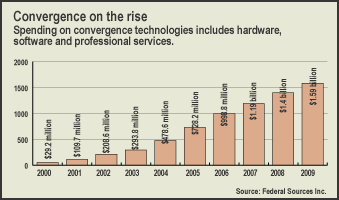It was while watching "The Perfect Storm" that Robert Bussabarger, network administrator for the city of Bend, Ore., became a true believer in Internet protocol-based telephony. Bussabarger was watching the movie over a data network connection ? while holding a videoconferencing session and fielding a phone call on that same fiber link.The city wanted to demonstrate to local businesses how robust Internet protocol, or IP, networks could be. So Bussabarger put his own network through a perfect storm: a torrent of simultaneous voice, video and data transmissions from a nearby fire station. Even he was surprised at the results. "We throttled it way up," Bussabarger said. Still, the network switches kept pace. The movie didn't skip frames, the videoconference didn't jump, and the voices over the phone didn't sound clipped or echoey. "At that point I thought this is pretty damn solid. We didn't have a hiccup, not even a glitch," he said. And it all ran on IP. Bend has found, just as other government agencies are finding, that the technologies for piggybacking phone service over data networks are robust enough for everyday use, at least in niche areas. And with manufacturers such as Cisco Systems Inc., San Jose Calif., aggressively marketing IP-enabled telephony products, industry observers predict agencywide internal phone networks, called private branch exchanges, or PBXs, may be soon eliminated altogether in favor of "converged" data and voice networks. The converged networks will cost less, simplify infrastructures and enable new services. These advantages are spurring a rapidly growing government market. The federal market for convergence solutions, which includes hardware, software and professional services, is expected to grow from $208.6 million in fiscal 2002 to $1.6 billion in 2009, according to research firm Federal Sources Inc., McLean, Va.Yet the agencies and integrators building convergent networks will be beset with major challenges. Agencies must overcome turf wars and jiggle the voice and data budget lines; neither is an easy task in a bureaucratic environment. And integrators hoping to snare new convergence opportunities will encounter fierce competition from telecom carriers also seeking dominance in this combined market of IT support and access services. "It's not completely clear that the integrators will own the converged solution space," said Warren Suss, head of telecommunications industry analyst firm Suss Consulting, Jenkintown, Pa.XXXSPLITXXX-"It's not a matter of if IP will replace PBX systems, it's a matter of when," said Bob Bruce, vice president in charge of U.S. channels for Cisco. "I'll go in and offer a business communications proposal that includes voice and data. In essence, the data network becomes a replacement for the PBX, which is not needed anymore."Bruce is understandably bullish on IP telephony. Cisco, whose routers are used widely throughout the Internet, invested heavily in research and development of IP telephony, and the company is now one of the main proponents of the convergence technology.Bruce cited a study by London telecommunications analyst PBI Media Ltd. that predicted half of all telephone handsets shipped worldwide in 2005 ? between 15 million and 20 million ? would be IP handsets, up from an already surprisingly large 14 percent in 2001. As for the government space, Bruce said Cisco partners have IP deployments in the Navy, FBI, Federal Trade Commission, Social Security Administration, Environmental Protection Agency and Federal Communications Commission. Shane Satterlund, a senior manager in federal services for KPMG Consulting Inc., McLean, Va., said the company is increasingly employing convergence technologies in its government work, at least in small doses, for tasks such as connecting branch offices. These deployments are giving agencies a feel for what the technology can do."A few years ago there was a lot of debate over whether the IP technology was going to be a viable alternative. There was a lot of opposition from the traditional voice community over whether or not that would ever work," Satterlund said. As the technology improves, more organizations are taking a serious look at how it can be used. "Convergence is a real option, and we are including it in our planning considerations," said Mark Day, deputy chief information officer for EPA.However, Day and others also said agencies hesitate to begin mass deployment."Using [convergent technologies] creates certain obvious value but also demands certain things of an infrastructure," Day said. Many agencies' data networks aren't yet capable of handling the heavy telephone traffic. And upgrades require immense amounts of capital, he said.It is also difficult to make a business case for replacing PBXs that are already working fine. "The way the government contracts are set up, there's a lot of investment that will be in place for some time," Satterlund said. "It would be hard for agencies to cancel these contracts and replace infrastructure investments they made as recently as a year or two ago."XXXSPLITXXX-The biggest obstacles to convergence, however, may be bureaucratic turf wars over who will control both voice and data systems. That's because the budgets for telephone service and IT support often fall to separate departments within an agency. "There is a lot of support at the agency level to have telecommunications and data converge, but the problem I see is that they are separately funded line items," said Dale McHenry, a senior vice president for enterprise consulting services at SI International Inc., McLean, Va. "Until the money converges, there will still be two separate customers in a lot of these deals.""Many barriers are not technical ones but the politics of IT," Suss said. "Traditionally, the agency people who control the networks have been very different groups than the folks who have controlled the application side and the IT infrastructure. Both want to keep their jobs."One high-profile convergence venture is the Navy-Marine Corps Intranet project, a $6.9 billion undertaking to provide desktop, network and communications services to 360,000 service personnel, led by Electronic Data Systems Corp., Plano, Texas. The Navy phone infrastructure was so woefully outdated that "drastic measures were needed," Suss said. "It took very strong leadership from the very highest level of operations to make that shift," he said. "Certainly, cost is one factor, but you need extremely strong leadership to cut across many fiefdoms."XXXSPLITXXX-A seemingly lucky confluence of factors propelled the city of Bend to the forefront of convergence use. The town government was small enough that the IT team could overcome bureaucratic red tape, yet its rapidly growing population (50,000 and rising) ensured a healthy infrastructure budget. Perhaps most importantly, it had a brand new dedicated fiber network that had been installed by the local cable company in exchange for city conduit space.And none too soon, either. Bend found itself constantly building out its telephone system."It was pretty ugly and costly," Bussabarger said. "We had all these disparate phone systems that were becoming unmanageable." The city was paying monthly leasing fees for the lines and retainers to keep telecom experts on standby, he said. At the time, the fire department was adding four new units and was willing to take on additional cost to standardize the system. So Bend's IT team assembled a request for quotes for a converged network, one that used Bend's new fiber backbone, for approximately 200 seats. It was won in August 2000 by Obsidian Technologies Inc., a Cisco IP solution provider in Eugene, Ore.From this initial project the city has expanded its IP network to other departments. When the town's public works department needed to upgrade its legacy switch to provide more phone lines, the lowest bid submitted for standard PBX equipment was $26,000, which didn't include installation and yearly maintenance fees, Bussabarger said. So the city purchased IP equipment, which cost about $16,000, and installed the system itself.One advantage of using an IP-based system is that maintenance and installation can be executed by trained network administrators rather than by specialized telephony consultants, Bussabarger said.Bussabarger himself had no IP telephony experience, but quickly learned what he needed to know because of his background in data networking. "One nice thing about the system is that it is very intuitive," he said. For example, moving an employee around the office is a snap, said Tony Foy, director of sales and marketing for Obsidian. The changeover requires no further reconfiguration than replugging a phone into the Ethernet jack at the new location. The server handles the rest.XXXSPLITXXX-In one sense, many government agencies are already preparing themselves for convergence by outsourcing both data and telephone functions under single IT outsourcing contracts. San Diego County, for example, combined telecom and data networking in a seven-year, $644 million contract for applications, telephones, networks and desktop and data center operations. The work was won in October 1999 by a team spearheaded by Computer Sciences Corp., El Segundo, Calif. Lana Willingham, San Diego County deputy administrative officer, said the impetus for the contract was that the county needed to recompete its telecom contract, so it made sense to add data networks. "It seemed to us that we were facing an unsustainable future when it came to the data side, because of the amount of money needed to bring the infrastructure where it should be," she said.Some of the services are combined at the backbone network, where voice and data traffic share routers and switches, Willingham said. However, this convergence does not extend into offices. Should the technology prove viable, the county will look at converged solutions for future reiterations of the contract, she said. The state of Georgia also is looking to combine voice and data services under a planned 10-year, $2 billion Converged Communications Outsourcing Project. The state can do so because both its data networking and telephone management duties fall under the domain of its technology authority office, allowing the consolidation of services in this one contract. However, Georgia's request for proposals does not mandate that data and voice services be physically bundled or converged."We're not dictating what kind of technologies should be used," said Michael Clark, a spokesperson for the technology authority. "The RFP focuses only on service levels." Solicitations are due in March, and a vendor should be chosen by late 2002.Other converged services contracts include one from the city of Chicago, which in December released an RFP for a metropolitan area network to provide integrated voice, video and data services for the city. Dubbed CivicNet, this network will be used by local industry as well, the officials hope. Also in December, Alaska awarded its five-year, $92 million agreement with telecom provider Alaska Communications Systems Inc. of Anchorage for combined Internet, phone, cell phone and videoconferencing. Integrators vs. telecom providersFor many of these converged services contracts, both access carriers and integrators are bidding for the work. The Georgia project, for instance, is being pursued by integrators such as Lockheed Martin Corp., Bethesda, Md., as well as by telecom access providers like WorldCom Inc., Clinton, Miss. "We'll see more competition between carriers and integrators," Suss said. "These are markets that have been, until recently, very separate."In his 1999 book "Telecommunications Convergence," analyst Steven Shepard predicted that transport carriers, with their glut of bandwidth left from over-optimistic build-outs in the late 1990s, will have to "climb the service food chain" and offer services to differentiate themselves."More and more customers want to buy all their needed services from a single provider," Shepard said. This sentiment was echoed by Natasha Haubold, spokesperson for WorldCom. She said WorldCom is seeing that organizations are starting to understand "that they need bandwidth and Internet services, not just dial tone. They recognize that all communications methods must integrate and provide new levels of productivity for their organizations," she said. While some see increased competition in this new space, others see cooperation. "What I'm seeing is an ecosystem developing," said Cisco's Bruce. "We work with the IBMs, EDSs, the Lockheed Martins of the world, as well as the WorldComs, Sprints and AT&Ts. I think you'll see a real collaboration where all are going to play in the marketplace."Ray Oleson, chairman and chief executive of SI International, said his company supports carriers with engineering and installation capabilities. In many cases, SI International also provides personnel with security clearances, as in a recent partnership with Qwest Communications International Inc., Denver, for an Air Force contract.Robin Lineberger, KPMG Consulting's senior vice president covering civilian agencies, said his company also views the carriers more as collaboration partners than as competitors. What KPMG Consulting brings to the table, he said, is expertise in helping clients use technology for process improvement. "We can work with the carriers to translate the client's business needs," he said.XXXSPLITXXX-Converging voice and data lines not only saves money, it also opens the door to a cornucopia of nifty new features. One example is videoconferencing systems that allow data collaboration, such as the iPower system offered by Polycom Inc., Milpitas, Calif. Last November, Polycom purchased rival PictureTel Corp. to take advantage of that company's work in PC-based architectures. Using an Intel-based server as the platform, a videoconferencing session can easily incorporate computer desktop applications into the video streams between locations. A conference attendee at one location can call up a Microsoft PowerPoint presentation, then hand over control of that application to an attendee at another location, while both can view document changes nearly instantly.Although data sharing was already possible in videoconferencing, the protocols were cumbersome and awkward, said Robert Dyer, Polycom's regional director for government accounts. An Internet protocol-based system better manages resources and provides a more familiar user environment. Another company with products combining voice and data is Cisco Systems Inc., San Jose, Calif., which has launched a line of IP telephony products with rich computer-enabled feature sets. Using Cisco's IP SoftPhone on a laptop along with its call manager server, users can take their phone extensions on the road and receive calls to their office numbers anywhere. They can also transfer calls using e-mail addresses.With the smart planning of integrators, eventually the voice and data worlds will converge into complex seamless systems. Integrator SI International Inc. is working on a Department of Defense prototype of an early warning system that cuts across the voice and data boundaries, said Dale McHenry, a federal program manager for the McLean, Va., company.In this system, sensors can be placed in various environments, such as water, or on sensitive inventory, such as ammunition. When these sensors detect disturbances, such as vibrations or humidity fluctuations, they will relay alerts back to a coordinating system via radio frequency signals. In turn, the coordinating system can automatically alert appropriate managers wherever they are at that moment, either by cell phone, laptop computer, desk phone or pager.XXXSPLITXXX-Companies that want to play the convergence game need to have skills in some of the following technologies. A telephone that works on Internet protocols. Can be either a standalone device or an application that will turn a PC into a phone. A newly emerging office area networking standard for transmitting 1 billion bits of information a second. Ethernet's advantage has always been its low cost, simplicity and maturity, and gigabit Ethernet raises the throughput from the 10 or 100 megabit standards of earlier iterations, easily allowing phone communications to piggyback on office networks. A telephony system built on an Internet protocol network instead of the traditional circuit-switched private branch exchange, or PBX, network is called an IP PBX system. The system includes components such as IP phones, a call processing system and access gateways. These are used to handle mixed network services. They differentiate between classes of network traffic and treat them accordingly, so bandwidth is not wasted. Uses of the tools include avoiding and managing network congestion, shaping network traffic and setting traffic priorities across the network.
Bending the rules: The city of Bend, Ore., merged its voice and data systems on an Internet protocol network, starting at the fire department. The team responsible for the city's initial IP foray included (clockwise from top left) Robert Bussabarger, network administrator; Don Jenson, deputy fire chief; Steve Meyers, IT director.
"It's not a matter of if IP will replace PBX systems, it's a matter of when." | Bob Bruce, vice president in charge of U.S. channels for Cisco

"Being able to plug the phones in anywhere and have them work [has] helped us use our time more effectively and productively." | Bend, Ore., deputy fire chief Don Jenson




